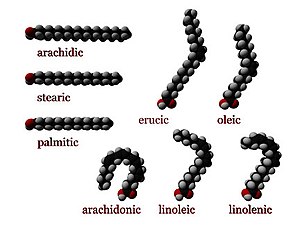The chemical structure of linoleic acid, a common omega-6 fatty acid found in many nuts, seeds and vegetable oils.
Omega-6 fatty acids (also referred to as ω-6 fatty acids or n-6 fatty acids) are a family of polyunsaturated fatty acids that have in common a final carbon-carbon double bond in the n-6 position, that is, the sixth bond, counting from the methyl end. Members of the family can have pro-inflammatory or anti-inflammatory effects.
The biological effects of the omega-6 fatty acids are largely
produced during and after physical activity for the purpose of promoting
growth and during the inflammatory cascade to halt cell damage and
promote cell repair by their conversion to omega-6 eicosanoids that bind to diverse receptors found in every tissue of the body.
Biochemistry
Linoleic acid (18:2, n−6), the shortest-chained omega-6 fatty acid, is one of many essential fatty acids and is categorized as an essential fatty acid because the human body cannot synthesize it. Mammalian cells lack the enzyme omega-3 desaturase
and therefore cannot convert omega-6 fatty acids to omega-3 fatty
acids. Closely related omega-3 and omega-6 fatty acids act as competing
substrates for the same enzymes. This outlines the importance of the proportion of omega-3 to omega-6 fatty acids in a diet.
Medical research on humans found a correlation (though correlation does not imply causation)
between the high intake of omega-6 fatty acids from vegetable oils and
disease in humans. However, biochemistry research has concluded that air pollution, heavy metals, smoking, passive smoking, lipopolysaccharides, lipid peroxidation
products (found mainly in vegetable oils, roasted nuts and roasted oily
seeds) and other exogenous toxins initiate the inflammatory response in
the cells which leads to the expression of the COX-2 enzyme and subsequently to the temporary production of inflammatory promoting prostaglandins from arachidonic acid for the purpose of alerting the immune system of the cell damage and eventually to the production of anti-inflammatory molecules (e.g. lipoxins & prostacyclin) during the resolution phase of inflammation, after the cell damage has been repaired.
Pharmacology
The conversion of cell membrane arachidonic acid (20:4n-6) to omega-6 prostaglandin and omega-6 leukotriene
eicosanoids during the inflammatory cascade provides many targets for
pharmaceutical drugs to impede the inflammatory process in atherosclerosis, asthma, arthritis, vascular disease, thrombosis, immune-inflammatory processes, and tumor proliferation. Competitive interactions with the omega-3 fatty acids affect the relative storage, mobilization, conversion and action of the omega-3 and omega-6 eicosanoid precursors.
Health effects
Some medical research suggests that excessive levels of omega-6 fatty acids from seed oils relative to certain omega-3 fatty acids may increase the probability of a number of diseases.
However, consumption of non-rancid nuts, which are high in omega 6, is
associated with a lower risk for some diseases, such as cardiovascular diseases including coronary heart disease (CHD), cancer, stroke, heart attacks, and lower rates of premature death.
Modern Western diets typically have ratios of omega-6 to omega-3
in excess of 10, some as high as 30; the average ratio of omega-6 to
omega-3 in the Western diet is 15–16.7.
Humans are thought to have evolved with a diet of a 1-to-1 ratio of
omega-6 to omega-3 and the optimal ratio is thought to be 4 or lower, although some sources suggest ratios as low as 1. A ratio of 2–3 omega-6 to omega-3 helped reduce inflammation in patients with rheumatoid arthritis. A ratio of 5 had a beneficial effect on patients with asthma but a ratio of 10 had a negative effect. A ratio of 2.5 reduced rectal cell proliferation in patients with colorectal cancer, whereas a ratio of 4 had no effect.
Excess omega-6 fatty acids from vegetable oils interfere with the
health benefits of omega-3 fats, in part because they compete for the
same rate-limiting enzymes. A high proportion of omega-6 to omega-3 fat
in the diet shifts the physiological state in the tissues toward the
pathogenesis of many diseases: prothrombotic, proinflammatory and
proconstrictive.
Chronic excessive production of omega-6 eicosanoids is correlated
with arthritis, inflammation, and cancer. Many of the medications used
to treat and manage these conditions work by blocking the effects of the
COX-2 enzyme.
Many steps in formation and action of omega-6 prostaglandins from
omega-6 arachidonic acid proceed more vigorously than the corresponding
competitive steps in formation and action of omega-3 hormones from
omega-3 eicosapentaenoic acid. The COX-1 and COX-2 inhibitor medications, used to treat inflammation and pain, work by preventing the COX enzymes from turning arachidonic acid into inflammatory compounds. The LOX inhibitor medications often used to
treat asthma work by preventing the LOX enzyme from converting arachidonic acid into the leukotrienes. Many of the anti-mania medications used to treat bipolar disorder work by targeting the arachidonic acid cascade in the brain.
A high consumption of oxidized polyunsaturated fatty acids (PUFAs), which are found in most types of vegetable oil, may increase the likelihood that postmenopausal women will develop breast cancer. Similar effect was observed on prostate cancer, but the study was performed on mice. Another "analysis suggested an inverse association between total polyunsaturated fatty acids
and breast cancer risk, but individual polyunsaturated fatty acids
behaved differently [from each other]. [...] a 20:2 derivative of linoleic acid [...] was inversely associated with the risk of breast cancer".
Omega-6 consumption
Industry-sponsored studies have suggested that omega-6 fatty acids should be consumed in a 1:1 ratio to omega-3, though it has been observed that the diet of many individuals today is at a ratio of about 16:1, mainly from vegetable oils. Omega-6 and omega-3 are essential fatty acids that are metabolized by some of the same enzymes, and therefore an imbalanced ratio can affect how the other is metabolized. In a study performed by Ponnampalam,
it was noticed that feeding systems had a great effect on nutrient
content on the meat sold to consumers. Cynthia Doyle conducted an
experiment to observe the fatty acid content of beef raised through
grass feeding versus grain feeding; she concluded that grass fed animals
contain an overall omega-6:omega-3 ratio that is preferred by
nutritionists.
In today's modern agriculture, the main focus is on production
quantity, which has decreased the omega-3 content, and increased the
omega-6 content, due to simple changes such as grain-feeding cattle.
In grain-feeding cattle, this is a way to increase their weight and
prepare them for slaughter much quicker compared to grass-feeding. This
modern way of feeding animals may be one of many indications as to why
the omega-6:omega-3 ratio has increased.
List of omega-6 fatty acids
| Common name | Lipid name | Chemical name |
|---|---|---|
| Linoleic acid (LA) | 18:2 (n−6) | all-cis-9,12-octadecadienoic acid |
| Gamma-linolenic acid (GLA) | 18:3 (n−6) | all-cis-6,9,12-octadecatrienoic acid |
| Calendic acid | 18:3 (n−6) | 8E,10E,12Z-octadecatrienoic acid |
| Eicosadienoic acid | 20:2 (n−6) | all-cis-11,14-eicosadienoic acid |
| Dihomo-gamma-linolenic acid (DGLA) | 20:3 (n−6) | all-cis-8,11,14-eicosatrienoic acid |
| Arachidonic acid (AA, ARA) | 20:4 (n−6) | all-cis-5,8,11,14-eicosatetraenoic acid |
| Docosadienoic acid | 22:2 (n−6) | all-cis-13,16-docosadienoic acid |
| Adrenic acid | 22:4 (n−6) | all-cis-7,10,13,16-docosatetraenoic acid |
| Osbond acid | 22:5 (n−6) | all-cis-4,7,10,13,16-docosapentaenoic acid |
| Tetracosatetraenoic acid | 24:4 (n−6) | all-cis-9,12,15,18-tetracosatetraenoic acid |
| Tetracosapentaenoic acid | 24:5 (n−6) | all-cis-6,9,12,15,18-tetracosapentaenoic acid |
The melting point of the fatty acids increase as the number of carbons in the chain increases.
Dietary linoleic acid requirement
Adding
more controversy to the omega-6 fat issue is that the dietary
requirement for linoleic acid has been questioned, because of a
significant methodology error proposed by University of Toronto scientist Stephen Cunnane.
Cunnane proposed that the seminal research used to determine the
dietary requirement for linoleic acid was based on feeding animals
linoleic acid-deficient diets, which were simultaneously deficient in
omega-3 fats. The omega-3 deficiency was not taken into account. The
omega-6 oils added back systematically to correct the deficiency also
contained trace amounts of omega-3 fats. Therefore, the researchers were
inadvertently correcting the omega-3 deficiency as well. Ultimately,
it took more oil to correct both deficiencies. According to Cunnane,
this error overestimates linoleic acid requirements by 5 to 15 times.
Dietary sources
The evening primrose flower (O. biennis) produces an oil containing a high content of γ-linolenic acid, a type of omega-6 fatty acid.
Four major food oils (palm, soybean, rapeseed, and sunflower)
provide more than 100 million metric tons annually, providing more than
32 million metric tons of omega-6 linoleic acid and 4 million metric
tons of omega-3 alpha-linolenic acid.
Dietary sources of omega-6 fatty acids include:





